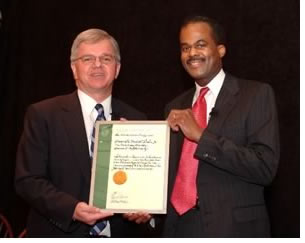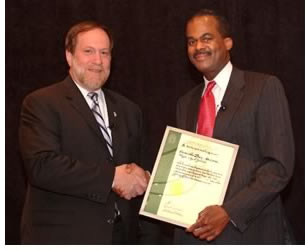

5/2006

by Terrence E. O’Neal,
AIA
President, AIA New York State
 Many American cities have deteriorated over the past 40 years as people
have abandoned urban areas for the suburbs, following the dominant value
system in our culture that holds “a house in the suburbs is better.” More
recently, the historic preservation movement, among other influences,
has rekindled interest in older structures and urban living. The perception
that center-city areas are for the less affluent began to disappear when
young urban professionals (the so-called “yuppies”) began
their return to major cities.
Many American cities have deteriorated over the past 40 years as people
have abandoned urban areas for the suburbs, following the dominant value
system in our culture that holds “a house in the suburbs is better.” More
recently, the historic preservation movement, among other influences,
has rekindled interest in older structures and urban living. The perception
that center-city areas are for the less affluent began to disappear when
young urban professionals (the so-called “yuppies”) began
their return to major cities.
This dichotomy raises a question for all of us: How should we allocate resources today—for urban renewal, suburban initiatives, or both? A symposium hosted by AIA New York State (AIANYS) on April 5 to celebrate the chapter’s 75th anniversary set out to address this and related issues. Entitled “One New York State: Urban Policy and Regional Design,” the symposium took on the ambitious goal of unifying the state, while its overall objective was to foster relationships between architects and elected officials statewide to address the scarcity of livable communities and other dominant issues facing New York State’s cities.
Universal challenges
Mayors Gerald D. Jennings of Albany, Matthew J. Driscoll of Syracuse,
and Philip A. Amicone of Yonkers addressed these at the event, as did
Assemblyman Fred W. Thiele Jr. of Suffolk County and Paula Luria Caplan,
deputy director of planning and development of Bronx Borough President
Carrion’s office. Peter A. Baynes, executive director of the
New York Conference of Mayors served as moderator, and former Mayor
William A. Johnson Jr. of Rochester delivered the keynote address.
 The symposium focused on waterfront development, transportation, affordable
housing, downtown revitalization, and brownfield redevelopment. Each
community has achieved some success in one or two of these areas, and
the speakers illustrated their remarks with plans, photographs, and renderings
of successful projects. They also explored visions they and others have
for their cities, and each enlisted the assistance of the architectural
community.
The symposium focused on waterfront development, transportation, affordable
housing, downtown revitalization, and brownfield redevelopment. Each
community has achieved some success in one or two of these areas, and
the speakers illustrated their remarks with plans, photographs, and renderings
of successful projects. They also explored visions they and others have
for their cities, and each enlisted the assistance of the architectural
community.
Almost unanimously, each official bemoaned the lack of a consistent policy for New York State’s cities. Former Mayor Johnson offered a proposal for a federal policy to assist cities. He noted that President Bush assigned an official to oversee redevelopment of New Orleans, and the federal government is very involved with rebuilding. He suggested that this degree of participation become a matter of policy nationwide instead of an isolated response to a crisis or emergency.
Looking at the laws
New York State’s Wicks Law requires publicly funded construction
projects to bid as separate contracts. Architects and others have opposed
this provision. Construction costs are increased by as much as 30 percent
under this procurement method. Elected officials at the symposium pledged
to work with architects throughout the state to repeal or reform the
law.
 The Historic Homes Tax Credit bill now in the New York State Assembly
and Senate was next on the agenda. The mayors agreed that passing this
provision would be a major boon in revitalizing downtown areas, especially
upstate cities, and that architects are effective partners in supporting
such provisions. The AIA has supported similar federally funded provisions
for several years.
The Historic Homes Tax Credit bill now in the New York State Assembly
and Senate was next on the agenda. The mayors agreed that passing this
provision would be a major boon in revitalizing downtown areas, especially
upstate cities, and that architects are effective partners in supporting
such provisions. The AIA has supported similar federally funded provisions
for several years.
Housing, transportation, education
Assemblyman Thiele spoke about affordable housing and the acute need
for “worker housing” on Long Island, where people other
than the wealthy often can’t afford to live. Tax credits could
go a long way to provide affordable housing. Mayor Driscoll agreed
that tax credits would also help revitalize downtown Syracuse. Architects,
they say, can be influential advocates for local ordinances that allow
additional market-rate units to be built in exchange for affordable
units. Syracuse proposes to revise land-use regulations with the help
of architects and introduce mixed-use development with residential
above retail use to add life to its downtown.
Thiele stressed transportation issues. On Long Island, the “one way in, one way out” system poses a huge problem: Automobile congestion on Long Island is unsurpassed in New York State. Thiele praised the entrepreneurs who created the Hampton Jitney. They marketed the idea of taking a bus so well that “catching the Jitney” has become the way to travel to the Hamptons.
The education system was the next issue. Good schools attract home buyers and, consequently, developers. Mayor Amicone and the City of Yonkers have attracted development despite perceived problems with the school system. The result: many affluent residents send their children to private and parochial schools.
 On the waterfronts
On the waterfronts
We identified common statewide issues. Nearly all communities in our
state are faced with obsolete industrial waterfront structures and
inadequate public access to the water. Since the 1980s in Manhattan,
riverfronts have been incrementally revitalized with esplanades and
other public walkways. Plans are in place for Brooklyn Bridge Park.
Mayor Amicone has plans for the Yonkers’ waterfront, and Borough
President Carrion is seeing redevelopment on portions of the Bronx’s
75 miles of shoreline. In Suffolk County, however, scenic waterfronts
are on privately owned property, not available to the public. The City
of Ithaca is seeking development proposals for its Inlet Island, and
Rochester has been redeveloping its waterfront property for public
use over the past 10 years. Master plans are in place for several riverfront
projects in Albany, and Mayor Driscoll spoke of a major retail project
planned for the Syracuse waterfront. Mayor Jennings summarized that
residential, retail, and riverfront revitalizations constitute the
most important initiatives for cities in New York State.
Can we do it?
Can New York architects work as One State to address common issues? What
is the architect’s role in working with elected officials? Architects
acknowledged their potential leadership role in breakout sessions.
They concluded recommendations for action:
- Advocating for comprehensive master plans
- Becoming accessible to political leadership
- Leading the public to create livable, sustainable communities
- Being advocates for important community issues
- Recognizing that schools define a community
- Forming community design centers
- Joining community planning boards.
It’s clear that design is not the answer with many of these issues. The solutions go much deeper, and architects need to use their abilities as consensus builders and synthesizers of information from varying sources.
The symposium started a rapport between the elected officials and the architects of New York State. The benefits of collaboration between government and architecture should be far-reaching as the AIA national organization celebrates its 150th anniversary in 2007.
Copyright 2006 The American Institute of Architects.
All rights reserved. Home Page ![]()
![]()
Photos © Timothy Raab/Northern Photo.
![]()